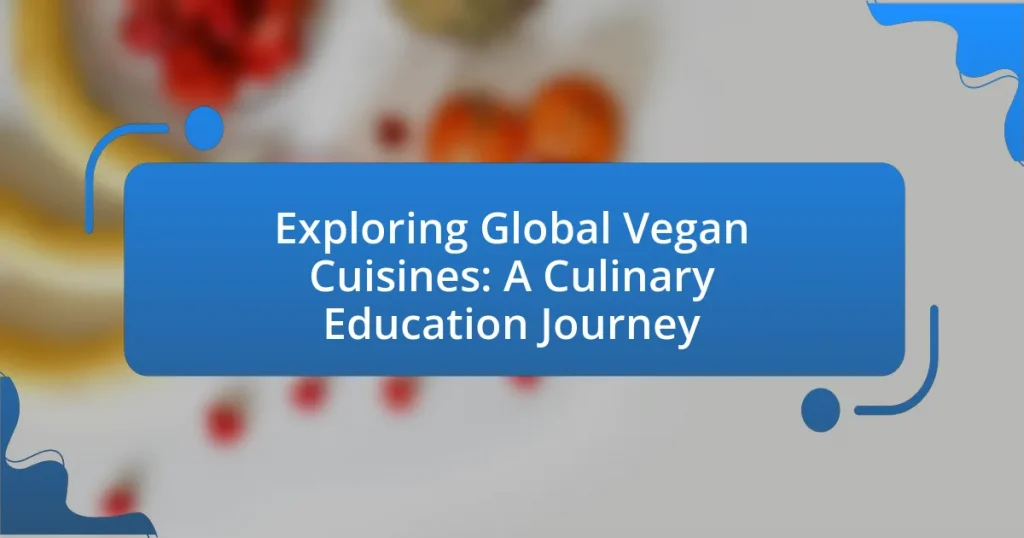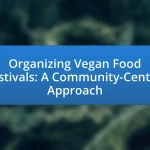Global Vegan Cuisine encompasses a wide array of plant-based dishes and culinary practices from various cultures, emphasizing ingredients such as fruits, vegetables, grains, legumes, nuts, and seeds while excluding all animal products. This cuisine differs from traditional diets by focusing solely on plant-based ingredients, reflecting diverse cultural influences and cooking techniques. The article explores the health benefits, sustainability aspects, and regional variations of Global Vegan Cuisine, highlighting key ingredients and traditional dishes from different cultures. Additionally, it discusses the growing popularity of veganism, practical tips for mastering vegan cooking, and resources available for culinary education in this field.
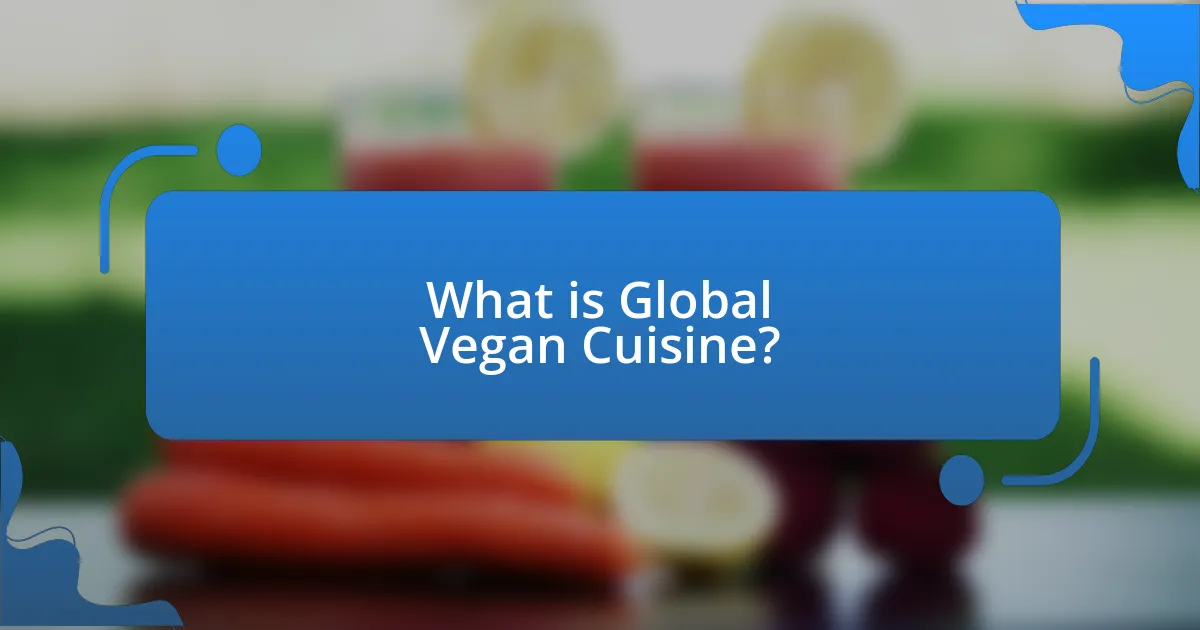
What is Global Vegan Cuisine?
Global Vegan Cuisine refers to a diverse range of plant-based dishes and culinary practices from various cultures around the world. This cuisine emphasizes the use of fruits, vegetables, grains, legumes, nuts, and seeds, while excluding all animal products. The global aspect highlights the unique flavors and cooking techniques that different regions contribute to vegan cooking, such as Indian curries, Mediterranean mezze, and East Asian stir-fries. The rise in popularity of Global Vegan Cuisine is supported by increasing awareness of health benefits, environmental sustainability, and ethical considerations related to animal welfare.
How does Global Vegan Cuisine differ from traditional cuisines?
Global Vegan Cuisine differs from traditional cuisines primarily in its exclusion of all animal products, including meat, dairy, and eggs. Traditional cuisines often incorporate these ingredients as staples, reflecting cultural practices and dietary habits. For instance, Mediterranean cuisine features olive oil, fish, and dairy, while Asian cuisines may include meat-based broths and seafood. In contrast, Global Vegan Cuisine utilizes plant-based ingredients such as legumes, grains, fruits, and vegetables to create diverse dishes that mimic the flavors and textures of traditional meals without animal-derived components. This shift not only caters to dietary preferences but also addresses ethical and environmental concerns associated with animal agriculture.
What are the key ingredients in Global Vegan Cuisine?
Key ingredients in Global Vegan Cuisine include legumes, grains, vegetables, fruits, nuts, seeds, and plant-based oils. Legumes such as lentils and chickpeas provide protein and fiber, while grains like quinoa and rice serve as staple carbohydrates. Vegetables, including leafy greens and root vegetables, offer essential vitamins and minerals. Fruits contribute natural sweetness and antioxidants. Nuts and seeds add healthy fats and protein, and plant-based oils, such as olive and coconut oil, are used for cooking and flavoring. This diverse array of ingredients reflects the culinary practices and nutritional needs across various cultures, making vegan cuisine both versatile and globally appealing.
How do cultural influences shape Global Vegan Cuisine?
Cultural influences shape Global Vegan Cuisine by integrating diverse culinary traditions, ingredients, and cooking techniques from various regions. For instance, Indian cuisine contributes a wide array of spices and legumes, while Mediterranean cultures emphasize fresh vegetables and grains, creating a rich tapestry of flavors and textures in vegan dishes. The adaptation of traditional recipes to exclude animal products reflects local customs and dietary practices, such as the prevalence of plant-based diets in certain Asian cultures, which often prioritize vegetables and rice. This blending of cultural elements not only enhances the variety of vegan options available globally but also promotes a greater acceptance of veganism across different societies, as evidenced by the increasing popularity of vegan restaurants and products worldwide.
Why is Global Vegan Cuisine gaining popularity?
Global Vegan Cuisine is gaining popularity due to increasing awareness of health benefits, environmental concerns, and ethical considerations surrounding animal welfare. Research indicates that plant-based diets can reduce the risk of chronic diseases, such as heart disease and diabetes, which has led to a surge in consumer interest. Additionally, the environmental impact of animal agriculture, including greenhouse gas emissions and resource depletion, has prompted many to adopt vegan diets as a more sustainable choice. According to a report by the Plant Based Foods Association, the plant-based food market grew by 27% in 2020, reflecting a significant shift in consumer preferences towards vegan options.
What health benefits are associated with Global Vegan Cuisine?
Global Vegan Cuisine offers numerous health benefits, including reduced risk of chronic diseases, improved heart health, and enhanced digestive health. Research indicates that a plant-based diet is associated with lower rates of obesity, type 2 diabetes, and hypertension, primarily due to its high fiber content and low saturated fat levels. A study published in the Journal of the American Heart Association found that individuals following a vegan diet had a 32% lower risk of heart disease compared to those consuming meat. Additionally, the abundance of fruits, vegetables, whole grains, and legumes in Global Vegan Cuisine contributes to better nutrient intake, including vitamins, minerals, and antioxidants, which support overall health and well-being.
How does Global Vegan Cuisine contribute to sustainability?
Global Vegan Cuisine contributes to sustainability by significantly reducing the environmental impact associated with animal agriculture. Studies indicate that plant-based diets can lower greenhouse gas emissions by up to 70% compared to diets high in animal products. Additionally, vegan cuisine promotes biodiversity by encouraging the consumption of a wide variety of plant foods, which helps maintain healthy ecosystems. Furthermore, the cultivation of plant-based ingredients typically requires less water and land than livestock farming, with estimates showing that producing one kilogram of beef requires approximately 15,000 liters of water, while producing one kilogram of vegetables requires only about 300 liters. This shift towards plant-based eating not only supports environmental health but also aligns with sustainable agricultural practices.
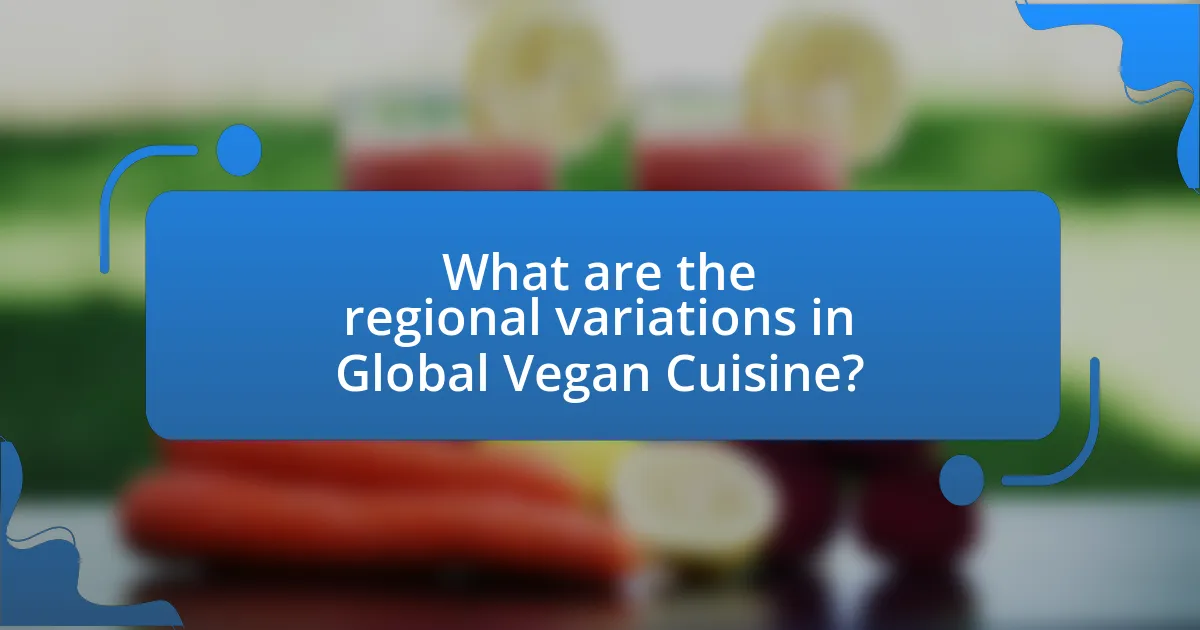
What are the regional variations in Global Vegan Cuisine?
Global vegan cuisine exhibits significant regional variations influenced by local ingredients, cultural practices, and culinary traditions. For instance, in India, vegan dishes often incorporate legumes, rice, and a variety of spices, reflecting the country’s diverse agricultural landscape and religious practices that promote vegetarianism. In contrast, Mediterranean vegan cuisine emphasizes fresh vegetables, grains, and olive oil, showcasing the region’s agricultural bounty and health-conscious dietary patterns. Additionally, East Asian vegan cuisine, particularly in countries like China and Japan, utilizes tofu, seaweed, and rice, highlighting the importance of umami flavors and seasonal ingredients. These variations are supported by the availability of local produce and the historical context of dietary practices in each region, demonstrating how geography and culture shape vegan culinary expressions globally.
How do different cultures interpret veganism?
Different cultures interpret veganism through various lenses, influenced by religious beliefs, environmental concerns, and health perspectives. For instance, in India, veganism is often associated with the principle of ahimsa, or non-violence, rooted in Hinduism and Buddhism, leading to a significant vegetarian and vegan population. In contrast, Western cultures may view veganism primarily as a health-conscious lifestyle choice, with a growing emphasis on sustainability and animal rights, as evidenced by the rise of plant-based diets in countries like the United States and the United Kingdom. Additionally, in some African cultures, traditional diets may include plant-based foods, but the concept of veganism as a formal lifestyle is less prevalent, often overshadowed by economic factors and food accessibility. These interpretations highlight the diverse motivations and cultural contexts that shape the understanding of veganism globally.
What are some traditional vegan dishes from Asia?
Traditional vegan dishes from Asia include dishes such as Tofu Stir-Fry from China, Chana Masala from India, and Vegetable Sushi from Japan. Tofu Stir-Fry features tofu and a variety of vegetables, often seasoned with soy sauce, showcasing the use of plant-based protein in Chinese cuisine. Chana Masala is a spiced chickpea dish that is a staple in Indian cuisine, highlighting legumes as a primary source of nutrition. Vegetable Sushi, made with rice and assorted vegetables, represents the Japanese approach to fresh, plant-based ingredients. These dishes exemplify the rich diversity of vegan options available across Asian culinary traditions.
How is veganism represented in Mediterranean cuisine?
Veganism is represented in Mediterranean cuisine through a variety of plant-based dishes that emphasize vegetables, legumes, grains, and fruits. Traditional Mediterranean foods such as hummus, tabbouleh, and ratatouille showcase the region’s reliance on fresh, seasonal ingredients, making it inherently compatible with vegan diets. The Mediterranean diet, recognized by UNESCO as an Intangible Cultural Heritage, highlights the importance of plant-based foods, with studies indicating that it is associated with numerous health benefits, including reduced risk of chronic diseases. This culinary tradition not only supports veganism but also promotes sustainability and biodiversity through its focus on local produce.
What unique ingredients are used in various regional vegan dishes?
Unique ingredients in various regional vegan dishes include jackfruit in South Asian cuisine, which serves as a meat substitute due to its texture; nutritional yeast in North American dishes, providing a cheesy flavor; and tempeh in Indonesian cuisine, made from fermented soybeans, offering a rich source of protein. Additionally, quinoa, native to the Andes, is often used in South American vegan dishes for its high nutritional value. These ingredients are integral to their respective cuisines, enhancing flavor and nutritional profiles while adhering to vegan principles.
What are the staple ingredients in Latin American vegan cuisine?
The staple ingredients in Latin American vegan cuisine include beans, corn, rice, avocados, tomatoes, and various peppers. Beans serve as a primary protein source, while corn is foundational in dishes like tortillas and tamales. Rice complements many meals, and avocados provide healthy fats. Tomatoes and peppers add flavor and nutrition, commonly used in salsas and sauces. These ingredients reflect the region’s agricultural diversity and cultural heritage, making them essential to vegan dishes across Latin America.
How do spices and herbs enhance flavors in African vegan dishes?
Spices and herbs enhance flavors in African vegan dishes by adding depth, complexity, and distinct regional characteristics. For instance, spices like cumin, coriander, and paprika contribute earthy and warm notes, while herbs such as cilantro and mint provide freshness and brightness. The use of these ingredients is rooted in African culinary traditions, where they are often combined to create rich, layered flavors that define various regional cuisines. Research indicates that the diverse climates across Africa allow for a wide variety of spices and herbs to flourish, which in turn influences local cooking practices and flavor profiles.
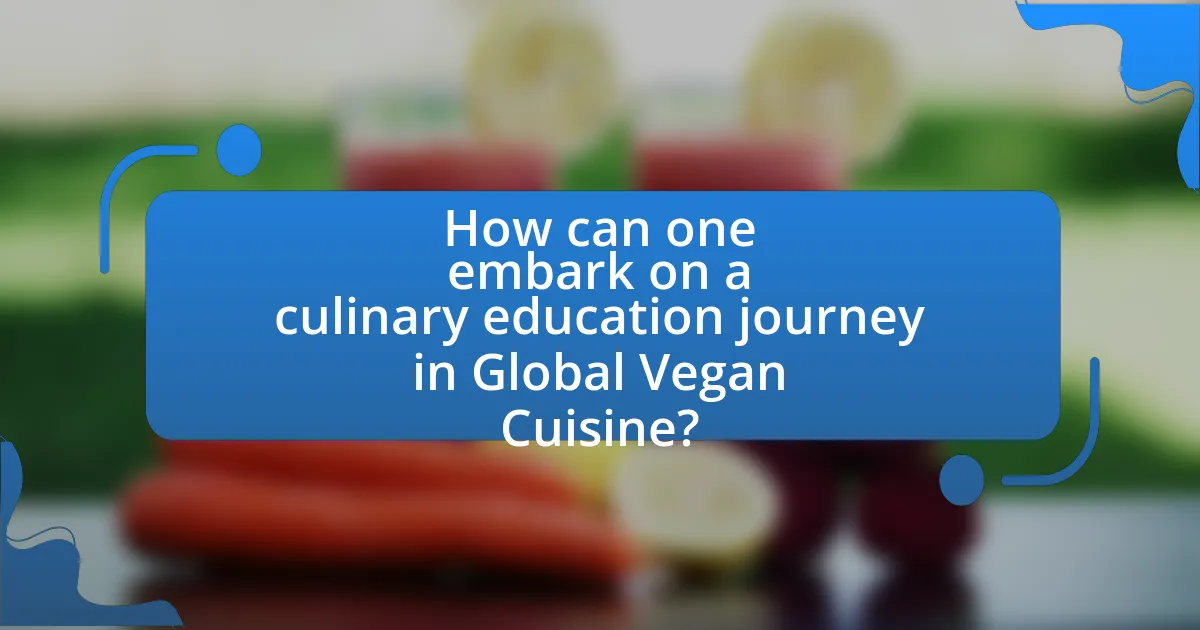
How can one embark on a culinary education journey in Global Vegan Cuisine?
To embark on a culinary education journey in Global Vegan Cuisine, one should enroll in specialized culinary programs that focus on plant-based cooking techniques and global cuisines. Many culinary schools now offer courses specifically tailored to vegan cuisine, covering diverse culinary traditions from around the world, such as Indian, Mediterranean, and Asian vegan dishes.
For instance, institutions like the Natural Gourmet Institute and the Vegan Culinary Academy provide comprehensive training in vegan cooking, emphasizing nutrition, flavor profiles, and sustainable practices. Additionally, participating in workshops, online courses, and internships with experienced vegan chefs can enhance practical skills and knowledge in this field.
Research indicates that the demand for plant-based culinary education is growing, with a 2021 report from the Plant-Based Foods Association highlighting a 27% increase in plant-based food sales in the U.S. over the previous year, underscoring the relevance and importance of this culinary niche.
What resources are available for learning Global Vegan Cuisine?
Online platforms such as Coursera, Udemy, and MasterClass offer courses specifically focused on Global Vegan Cuisine. These platforms provide structured learning experiences with video lectures, recipes, and community interaction. Additionally, cookbooks like “Veganomicon” by Isa Chandra Moskowitz and “Plenty” by Yotam Ottolenghi serve as comprehensive resources, featuring diverse vegan recipes from various cultures. Furthermore, websites like Minimalist Baker and Oh She Glows provide extensive recipe collections and cooking tips tailored to vegan diets. These resources collectively support individuals in exploring and mastering Global Vegan Cuisine.
What online courses focus on Global Vegan Cuisine?
Online courses that focus on Global Vegan Cuisine include “Vegan Cooking: Global Flavors” offered by the Rouxbe Culinary School, which teaches plant-based cooking techniques from various cultures. Another notable course is “Plant-Based Cooking for Everyone” by the Forks Over Knives team, emphasizing international vegan recipes. Additionally, the “Vegan International Cuisine” course on Udemy covers diverse vegan dishes from around the world, providing a comprehensive culinary education in global vegan cuisine. These courses are designed to enhance culinary skills while promoting a plant-based lifestyle.
How can cookbooks enhance your understanding of Global Vegan Cuisine?
Cookbooks enhance your understanding of Global Vegan Cuisine by providing diverse recipes, cultural context, and cooking techniques from various regions. They serve as educational resources that introduce readers to the ingredients, flavors, and traditional practices unique to different cultures, such as Indian, Mediterranean, or East Asian vegan dishes. For instance, a cookbook focused on Indian vegan cuisine may explain the use of spices like turmeric and cumin, which are integral to the region’s culinary identity. Additionally, cookbooks often include historical anecdotes and nutritional information, further enriching the reader’s knowledge and appreciation of global vegan practices. This combination of practical guidance and cultural insight makes cookbooks essential tools for anyone looking to explore and understand the vast landscape of Global Vegan Cuisine.
What practical tips can help in mastering Global Vegan Cuisine?
To master Global Vegan Cuisine, one should explore diverse ingredients and cooking techniques from various cultures. Familiarizing oneself with staples like legumes, grains, and vegetables from different regions enhances culinary versatility. For instance, understanding the use of spices in Indian cuisine or the preparation of tofu in East Asian dishes can significantly elevate vegan cooking skills. Additionally, practicing traditional recipes from various countries, such as Ethiopian injera or Mexican mole, allows for a deeper appreciation of global flavors. Engaging with local vegan communities or online forums can provide valuable insights and tips, further enriching the learning experience.
How can one effectively substitute non-vegan ingredients in recipes?
One can effectively substitute non-vegan ingredients in recipes by using plant-based alternatives that mimic the texture and flavor of the original ingredients. For example, eggs can be replaced with flaxseed meal mixed with water, which acts as a binding agent, while dairy milk can be substituted with almond milk or oat milk, providing a similar consistency and taste. Research indicates that these substitutions not only maintain the integrity of the dish but also enhance its nutritional profile by reducing cholesterol and increasing fiber content.
What are the best practices for sourcing ingredients for Global Vegan Cuisine?
The best practices for sourcing ingredients for Global Vegan Cuisine include prioritizing local and seasonal produce, ensuring ethical sourcing, and selecting diverse ingredients that reflect global culinary traditions. Local and seasonal produce enhances freshness and reduces carbon footprint, while ethical sourcing supports sustainable farming practices and fair trade. Additionally, incorporating a variety of ingredients from different cultures enriches the culinary experience and promotes authenticity in vegan dishes. For instance, sourcing organic legumes from local farmers not only supports the community but also aligns with the principles of veganism by promoting plant-based diets.
What are common challenges faced when exploring Global Vegan Cuisine?
Common challenges faced when exploring Global Vegan Cuisine include ingredient availability, cultural acceptance, and culinary techniques. Ingredient availability can be a significant barrier, as certain plant-based foods may not be accessible in all regions, limiting the authenticity of dishes. Cultural acceptance poses another challenge, as some cultures may have traditional diets that heavily rely on animal products, making it difficult to introduce vegan alternatives. Additionally, mastering diverse culinary techniques from various global cuisines can be complex, as each culture has unique methods of preparation and flavor profiles. These challenges highlight the need for adaptability and creativity in the exploration of vegan cuisine across different cultures.
How can one overcome ingredient availability issues?
To overcome ingredient availability issues, one can utilize alternative ingredients that serve similar culinary functions. For instance, if a specific vegetable is unavailable, a similar variety can be substituted, or frozen options can be used as replacements. Research indicates that many chefs successfully adapt recipes by using local or seasonal produce, which not only addresses availability but also enhances flavor and freshness. Additionally, sourcing ingredients from local farmers’ markets or online specialty stores can provide access to hard-to-find items, ensuring a diverse range of options for vegan cooking.
What strategies can help in adapting recipes to local tastes?
To adapt recipes to local tastes, one effective strategy is to incorporate locally available ingredients that resonate with regional flavors. This approach not only enhances the dish’s authenticity but also aligns with the preferences of the local population. For example, using local spices, herbs, and vegetables can significantly alter the flavor profile of a recipe, making it more appealing to the target audience. Additionally, understanding cultural dietary restrictions and preferences, such as avoiding certain ingredients or emphasizing specific cooking methods, further tailors the recipe to local customs. Research indicates that food acceptance is closely linked to familiarity and cultural significance, reinforcing the importance of these adaptations in culinary practices.
